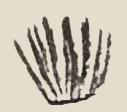tzontli (Mdz24v)
This black-line drawing of the element for the number 400 seems to consist of human hair or hairs (tzontli). This glyph has been carved from the compound sign for the place name, Tzompanco. The visual is spiky, with about ten upright hairs connected at the base with a horizontal line.
Stephanie Wood
Tzontli is a term not only for hairs but also for the number 400, as is centzontli, which refers to the full or entire tzontli, such as a large clump of human hair or something that looks like a tree. Apparently, a clump of human hair was once equated with the number 400, perhaps having 400 hairs in it. Before the letter "p" it is not at all unusual for a stem such as "tzon," ending in "n," to change to "tzom." Other representations of a human hair tzontli can be a ponytail of sorts, wrapped with a red leather thong (see below). Sometimes the tzontli or centzontli looks like a tree.
Stephanie Wood
c. 1541, but by 1553 at the latest
Stephanie Wood

tzon(tli), hair or hairs, or 400, https://nahuatl.wired-humanities.org/content/tzontli
centzon(tli), 400, https://nahuatl.wired-humanities.org/content/centzontli
hair or hairs
el cabello o cuatrocientos
Stephanie Wood
Codex Mendoza, folio 24 verso, https://digital.bodleian.ox.ac.uk/objects/2fea788e-2aa2-4f08-b6d9-648c00..., image 59 of 188.
The Bodleian Libraries, University of Oxford, hold the original manuscript, the MS. Arch. Selden. A. 1. This image is published here under the UK Creative Commons, “Attribution-NonCommercial-ShareAlike 3.0 License” (CC-BY-NC-SA 3.0).



